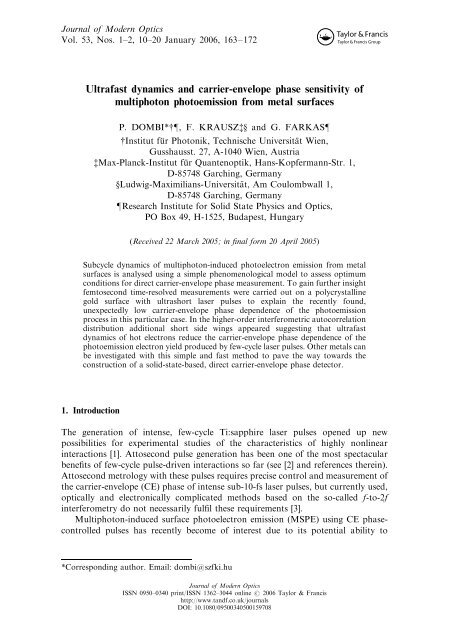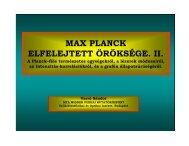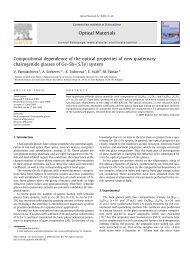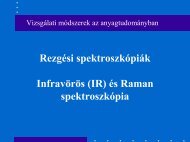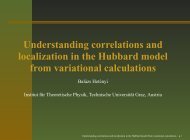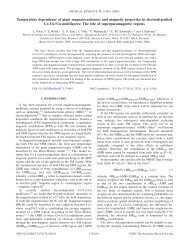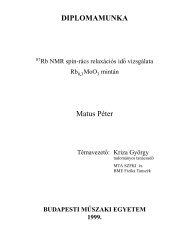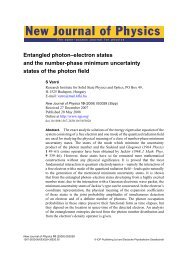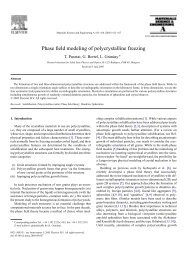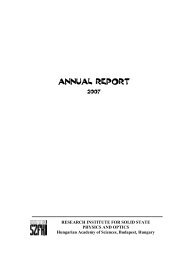Ultrafast dynamics and carrier-envelope phase sensitivity of ...
Ultrafast dynamics and carrier-envelope phase sensitivity of ...
Ultrafast dynamics and carrier-envelope phase sensitivity of ...
You also want an ePaper? Increase the reach of your titles
YUMPU automatically turns print PDFs into web optimized ePapers that Google loves.
Journal <strong>of</strong> Modern Optics<br />
Vol. 53, Nos. 1–2, 10–20 January 2006, 163–172<br />
<strong>Ultrafast</strong> <strong>dynamics</strong> <strong>and</strong> <strong>carrier</strong>-<strong>envelope</strong> <strong>phase</strong> <strong>sensitivity</strong> <strong>of</strong><br />
multiphoton photoemission from metal surfaces<br />
P. DOMBI*yô, F. KRAUSZz} <strong>and</strong> G. FARKASô<br />
yInstitut fu¨r Photonik, Technische Universita¨t Wien,<br />
Gusshausst. 27, A-1040 Wien, Austria<br />
zMax-Planck-Institut fu¨r Quantenoptik, Hans-Kopfermann-Str. 1,<br />
D-85748 Garching, Germany<br />
}Ludwig-Maximilians-Universita¨t, Am Coulombwall 1,<br />
D-85748 Garching, Germany<br />
ôResearch Institute for Solid State Physics <strong>and</strong> Optics,<br />
PO Box 49, H-1525, Budapest, Hungary<br />
(Received 22 March 2005; in final form 20 April 2005)<br />
Subcycle <strong>dynamics</strong> <strong>of</strong> multiphoton-induced photoelectron emission from metal<br />
surfaces is analysed using a simple phenomenological model to assess optimum<br />
conditions for direct <strong>carrier</strong>-<strong>envelope</strong> <strong>phase</strong> measurement. To gain further insight<br />
femtosecond time-resolved measurements were carried out on a polycrystalline<br />
gold surface with ultrashort laser pulses to explain the recently found,<br />
unexpectedly low <strong>carrier</strong>-<strong>envelope</strong> <strong>phase</strong> dependence <strong>of</strong> the photoemission<br />
process in this particular case. In the higher-order interferometric autocorrelation<br />
distribution additional short side wings appeared suggesting that ultrafast<br />
<strong>dynamics</strong> <strong>of</strong> hot electrons reduce the <strong>carrier</strong>-<strong>envelope</strong> <strong>phase</strong> dependence <strong>of</strong> the<br />
photoemission electron yield produced by few-cycle laser pulses. Other metals can<br />
be investigated with this simple <strong>and</strong> fast method to pave the way towards the<br />
construction <strong>of</strong> a solid-state-based, direct <strong>carrier</strong>-<strong>envelope</strong> <strong>phase</strong> detector.<br />
1. Introduction<br />
The generation <strong>of</strong> intense, few-cycle Ti:sapphire laser pulses opened up new<br />
possibilities for experimental studies <strong>of</strong> the characteristics <strong>of</strong> highly nonlinear<br />
interactions [1]. Attosecond pulse generation has been one <strong>of</strong> the most spectacular<br />
benefits <strong>of</strong> few-cycle pulse-driven interactions so far (see [2] <strong>and</strong> references therein).<br />
Attosecond metrology with these pulses requires precise control <strong>and</strong> measurement <strong>of</strong><br />
the <strong>carrier</strong>-<strong>envelope</strong> (CE) <strong>phase</strong> <strong>of</strong> intense sub-10-fs laser pulses, but currently used,<br />
optically <strong>and</strong> electronically complicated methods based on the so-called f-to-2f<br />
interferometry do not necessarily fulfil these requirements [3].<br />
Multiphoton-induced surface photoelectron emission (MSPE) using CE <strong>phase</strong>controlled<br />
pulses has recently become <strong>of</strong> interest due to its potential ability to<br />
*Corresponding author. Email: dombi@szfki.hu<br />
Journal <strong>of</strong> Modern Optics<br />
ISSN 0950–0340 print/ISSN 1362–3044 online # 2006 Taylor & Francis<br />
http://www.t<strong>and</strong>f.co.uk/journals<br />
DOI: 10.1080/09500340500159708
164 P. Dombi et al.<br />
overcome the above limitations [3–5]. Moreover, it could find novel applications<br />
related to ultrafast, keV photoelectron sources <strong>and</strong> detection <strong>and</strong> surface science<br />
[6, 7]. The femtosecond <strong>dynamics</strong> <strong>of</strong> MSPE has been studied extensively in the last<br />
decade by experts in the latter field, resulting in sophisticated, temporally, spectrally<br />
<strong>and</strong> spatially resolved electron emission studies (see [8, 9] <strong>and</strong> references therein).<br />
Related characterization methods, such as photoelectron emission microscopy<br />
(PEEM) were also upgraded for use with femtosecond lasers [10, 11] <strong>and</strong> femtosecond<br />
<strong>dynamics</strong> <strong>of</strong> the electronic states <strong>of</strong> surface adsorbates can also be studied<br />
with time-resolved two-photon photoemission methods [12]. In spite <strong>of</strong> these recent<br />
developments in basic research <strong>and</strong> methodology, studies in the few-cycle laser pulse<br />
length domain are scarce <strong>and</strong> thus the role <strong>of</strong> the CE <strong>phase</strong> in the photoemission<br />
process is not well understood, in spite <strong>of</strong> the enormous potential <strong>of</strong> this field. Such<br />
an underst<strong>and</strong>ing would pave the way towards surface attosecond science since<br />
in st<strong>and</strong>ard attosecond XUV/infrared pump-probe-like setups (that have been<br />
employed for the investigation <strong>of</strong> gas-<strong>phase</strong> interactions) in which one <strong>of</strong> the<br />
interacting fields is a CE <strong>phase</strong>-controlled infrared pulse [2].<br />
In this paper we present theoretical <strong>and</strong> experimental investigations with the aim<br />
<strong>of</strong> gaining insight into the subcycle <strong>and</strong> femtosecond <strong>dynamics</strong> <strong>of</strong> MSPE from metal<br />
surfaces using few-cycle Ti:sapphire laser pulses. A simple, phenomenological model<br />
is employed, the basics <strong>of</strong> which were described recently [3]. We develop it further to<br />
enable quantitative estimates for the photocurrent as a function <strong>of</strong> the CE <strong>phase</strong>.<br />
Our results can then be compared to those delivered by a sophisticated simulation<br />
using the jellium model <strong>of</strong> metals <strong>and</strong> density functional methods [4]. We carry out<br />
femtosecond time-resolved studies <strong>of</strong> the emission process with an inexpensive <strong>and</strong><br />
compact electron detector tube to assess potential additional effects not taken into<br />
account by the model. Our study sheds light on the possible origin <strong>of</strong> the recently<br />
found, unexpectedly low experimental dependence <strong>of</strong> laser-induced multiphoton<br />
electron emission on the CE <strong>phase</strong> [3, 5].<br />
2. Model for <strong>carrier</strong>-<strong>envelope</strong> <strong>phase</strong>-sensitive photoelectron emission<br />
To gain a deeper underst<strong>and</strong>ing <strong>of</strong> CE <strong>phase</strong>-sensitive MSPE, we adapt the so-called<br />
three-step semiclassical model <strong>of</strong> gas-<strong>phase</strong> high harmonic generation [13] to surface<br />
photoemission. In Corkum’s model the electron ionized by the field <strong>of</strong> a laser pulse is<br />
assumed to be ‘‘born’’ in the continuum with zero initial velocity after tunnelling<br />
through the potential barrier distorted by the laser field. Thereafter it is treated as a<br />
free particle <strong>and</strong> its trajectory is examined in the potential <strong>of</strong> the laser field only.<br />
Under certain conditions the wave packet returns to the parent ion <strong>and</strong> the<br />
subsequent recombination results in the emission <strong>of</strong> high-harmonic photons. This<br />
simple picture results in remarkably accurate quantitative predictions <strong>and</strong> forms the<br />
basis for a rigorous quantum mechanical treatment <strong>of</strong> the process [14]. Obviously,<br />
the time <strong>of</strong> birth, the instant <strong>of</strong> the recombination, <strong>and</strong> consequently the temporal<br />
<strong>and</strong> spectral characteristics <strong>of</strong> the XUV emission are also influenced by the CE <strong>phase</strong><br />
<strong>of</strong> the laser pulse provided that the generating pulses have few-cycle duration.
Carrier-<strong>envelope</strong> <strong>phase</strong>-sensitive photoemission 165<br />
The model can be adapted to MSPE to account for CE <strong>phase</strong> effects. The first<br />
step corresponds to instantaneous electron emission as a result <strong>of</strong> which a free<br />
electron is ‘‘born’’ somewhere near the metal surface. We assume that the probability<br />
<strong>of</strong> the emission is proportional to A(t) 2n , where A(t) is the <strong>envelope</strong> <strong>of</strong> a laser pulse<br />
the E-field <strong>of</strong> which is described by E(t) ¼ A(t) cos(! 0 t þ ’ CE ). (Here ! 0 is the <strong>carrier</strong><br />
frequency <strong>and</strong> ’ CE denotes the <strong>carrier</strong>-<strong>envelope</strong> <strong>phase</strong>.) The order <strong>of</strong> nonlinearity <strong>of</strong><br />
the process is denoted by n, <strong>and</strong> the A(t) 2n -assumption for the emission probability is<br />
in accordance with the perturbative nature <strong>of</strong> MSPE <strong>and</strong> well-known, justified<br />
intensity dependence laws.<br />
The second step in our treatment is to determine the motion <strong>of</strong> the electron near<br />
the surface. Trajectories are assumed to be influenced only by the laser field <strong>and</strong> the<br />
mirror charge potential. The latter effect appears to be negligible according to<br />
numerical simulations. Depending on the actual CE <strong>phase</strong> <strong>of</strong> the pulse the field<br />
evolution will push the electron back to the surface either immediately upon emission<br />
(figure 1; the hypothetical thin dash-dotted line is in the z < 0 region, which means<br />
an assumption <strong>of</strong> no emission taking place) or after performing a wiggle in the<br />
laser field.<br />
It is also possible that the electron is able to escape (figure 1, thick dash-dotted<br />
line). As an example, figure 1 shows calculations for an electron that is released<br />
exactly at the peak <strong>of</strong> the intensity <strong>envelope</strong> <strong>of</strong> the pulse. However, to gain<br />
Electric field strength <strong>and</strong><br />
emission probability (arb.)<br />
1<br />
0<br />
−1<br />
E-fields for<br />
ϕ CE = 0<br />
ϕ CE = π/2<br />
emission<br />
probability<br />
e − -trajectory, ϕ CE = 0<br />
e − -trajectory, ϕ CE = π/2<br />
2<br />
0<br />
−2<br />
−4<br />
−6<br />
−8<br />
Distance from surface (arb.)<br />
−8 −4 0 4 8<br />
Time (fs)<br />
Figure 1. Electric field evolution <strong>of</strong> a transform-limited cosine- (thick solid line) <strong>and</strong> a<br />
sine-pulse (thin solid line) in the case <strong>of</strong> a Gaussian 4 fs (intensity) <strong>envelope</strong>. The dotted line<br />
shows the photoemission probability assuming a third-order process. The dash-dotted lines<br />
depict classical trajectories <strong>of</strong> the electrons that are emitted with the highest probability at the<br />
peak <strong>of</strong> the pulse <strong>envelope</strong>. Since on the right axis the z < 0 region indicates the metal bulk, we<br />
assumed that when the trajectory hits this region no electron emission takes place.
166 P. Dombi et al.<br />
1.0<br />
Emmited charge (arb.)<br />
0.8<br />
0.6<br />
8<br />
0.4<br />
−1.0<br />
−0.5<br />
0.5<br />
1.0<br />
4<br />
5<br />
6<br />
7<br />
Pulse length (fs)<br />
Carrier-<strong>envelope</strong> <strong>phase</strong> (π)<br />
Figure 2. Photoelectron yield resulting from a simple model <strong>of</strong> CE <strong>phase</strong>-sensitive MSPE as<br />
a function <strong>of</strong> the CE <strong>phase</strong> <strong>and</strong> the pulse length. The figure is directly comparable to figure 2<br />
<strong>of</strong> [3].<br />
quantitative results other possible emission times (t i ) have to be taken into account.<br />
For each potential emission instant the favourable range <strong>of</strong> CE <strong>phase</strong>s can be<br />
determined in which the electron can escape. These ranges can then be overlapped<br />
with their corresponding weights <strong>of</strong> A(t i ) 2n resulting in a histogram-like distribution<br />
<strong>of</strong> electron release probabilities as a function <strong>of</strong> the CE <strong>phase</strong>.<br />
Following this method the CE <strong>phase</strong> dependence <strong>of</strong> the electron yield was<br />
estimated as a function <strong>of</strong> the pulse length. Results are depicted in figure 2 (for<br />
this a Gaussian, transform-limited pulse <strong>and</strong> n ¼ 3 were assumed, the latter corresponding<br />
to a gold surface illuminated by Ti:sapphire laser pulses).<br />
The surface plot gained in such a way can be compared directly to the one<br />
resulting from a sophisticated simulation <strong>of</strong> the process involving the jellium model<br />
<strong>of</strong> metals <strong>and</strong> density functional methods [3, 4] as depicted in figure 2 <strong>of</strong> [3].<br />
The agreement between the two curves computed with radically different methods<br />
is remarkable. Both the value <strong>of</strong> the CE <strong>phase</strong> at which maximum electron yield can<br />
be observed (’ CE,Max ¼ –p/4) <strong>and</strong> the modulation depth <strong>of</strong> the curves for different<br />
pulse lengths are also correct to within 10%. Bigger deviations than this can only be<br />
observed as moving away from the few-cycle case.<br />
In a similar way the CE <strong>phase</strong> dependence <strong>of</strong> MSPE can be examined with the<br />
order <strong>of</strong> nonlinearity <strong>of</strong> the emission process as a parameter. In figure 3 the cases
Carrier-<strong>envelope</strong> <strong>phase</strong>-sensitive photoemission 167<br />
1.0<br />
0.8<br />
Electron yield (arb.)<br />
0.6<br />
0.4<br />
0.2<br />
Order <strong>of</strong> nonlinearity:<br />
second<br />
third<br />
fourth<br />
sixth<br />
eighth<br />
0.0<br />
−1.0 −0.5 0.0 0.5 1.0<br />
Carrier-<strong>envelope</strong> <strong>phase</strong> (π)<br />
Figure 3. Photoelectron yield <strong>of</strong> MSPE induced by a 4 fs Gaussian pulse for metal surfaces<br />
with different work functions resulting in second-, third-, <strong>and</strong> fourth-order nonlinearities.<br />
n ¼ 2, 3, 4, 6 <strong>and</strong> 8 are depicted. In this way one can estimate the effect <strong>of</strong> using<br />
metals <strong>of</strong> different work functions at the Ti:sapphire wavelength (n ¼ 2, 3, 4). Higher<br />
order nonlinearities also come into play when it comes to CE <strong>phase</strong> detection <strong>of</strong> the<br />
planned ultrashort-pulsed chirped-pulse-amplified (CPA) lasers operating in the<br />
infrared (to be realized by broadb<strong>and</strong> optical parametric amplification). This<br />
wavelength shift with respect to st<strong>and</strong>ard Ti:sapphire lasers brings huge benefits to<br />
high-harmonic generation <strong>and</strong> attosecond applications because <strong>of</strong> the 2 -scaling <strong>of</strong><br />
the ponderomotive potential <strong>and</strong> thus the cut-<strong>of</strong>f frequency <strong>of</strong> high-harmonic<br />
generation. An additional benefit is that for these longer wavelengths the nonlinearity<br />
<strong>of</strong> the photoemission process is much higher <strong>and</strong> therefore chances <strong>of</strong><br />
measuring the <strong>carrier</strong>-<strong>envelope</strong> <strong>phase</strong> by MSPE (or any kind <strong>of</strong> nonlinear effect [15])<br />
increase enormously. The curves belonging to n ¼ 6 <strong>and</strong> 8 illustrate this effect. Taking<br />
the work function <strong>of</strong> gold <strong>and</strong> a 2 mm optical parametric CPA laser wavelength, one<br />
would expect an eighth-order nonlinearity. This increases the CE <strong>phase</strong>-dependent<br />
modulation drastically, as seen in figure 3.<br />
3. Experiments<br />
The next task is to detect any kind <strong>of</strong> ultrafast characteristic in the photoemission to<br />
assess potential additional effects causing the previously observed low CE <strong>phase</strong><br />
<strong>sensitivity</strong> <strong>of</strong> the electron yield [3, 5]. These effects are taken into account neither by<br />
the model in [4] nor by the one in the previous section. Experimental findings on the<br />
ultrafast <strong>dynamics</strong> <strong>of</strong> MSPE would eventually allow further refinement <strong>of</strong> the model.
168 P. Dombi et al.<br />
In the perturbative regime the photoemission process can be characterized by<br />
measuring the intensity <strong>and</strong> polarization dependences <strong>of</strong> the photocurrent.<br />
The dependence on the intensity j / I n (where I denotes the laser intensity)<br />
demonstrates the nth order perturbative multiphoton character <strong>of</strong> the interaction.<br />
The polarization dependence can demonstrate that the major contribution to the<br />
emission process is delivered by the field component perpendicular to the surface.<br />
Furthermore, MSPE as an nth-order detection process, may be used together with a<br />
Michelson interferometer as an extremely sensitive, nth-order intensity or interferometric<br />
autocorrelator to carry out ultrafast time-resolved experiments on the<br />
photoemission process.<br />
Following these considerations we used linearly polarized 0.9 mJ, 25 fs, 800 nm<br />
pulses from a chirped-pulse-amplified Ti:sapphire laser [16] <strong>and</strong> 0.3 mJ, 9.5 fs, 750 nm<br />
pulses from a subsequent hollow-fibre/chirped-mirror compressor to study these<br />
phenomena. With these pulses we induced photoemission from a 1 mm thick,<br />
polished, chemically treated <strong>and</strong> baked polycrystalline gold surface. It was placed<br />
in a sealed glass tube (10 7 mbar) together with the electron collecting electrode kept<br />
at 15 kV. The thickness <strong>of</strong> the optical window <strong>of</strong> the vacuum vessel was reduced to<br />
1.1 mm. This amount <strong>of</strong> glass was compensated for by inserting an extra chirped<br />
mirror in the beam path. The pulses were focused at a 80 grazing incidence angle<br />
on the surface. From the W ¼ 4.6 eV work function value <strong>of</strong> gold <strong>and</strong> the 1.55 eV<br />
laser photon energy it follows that n ¼ [W/h! 0 þ 1] ¼ 3 (square brackets here indicate<br />
the greatest integer smaller than the argument).<br />
In the first experiment to confirm the order <strong>of</strong> nonlinearity <strong>of</strong> the effect (i.e. the<br />
value n) the j ¼ f (I ) intensity dependence was measured. The laser intensity variation<br />
was limited to the 10 10 10 12 W/cm 2 range (to avoid both the eventual space charge<br />
saturation <strong>and</strong> the tunnel effect) <strong>and</strong> was realized by Fresnel reflecting a portion <strong>of</strong><br />
the beam <strong>of</strong>f 5 mm thin pellicle beamsplitters at different angles <strong>of</strong> incidence (<strong>and</strong><br />
using, <strong>of</strong> course, the transmitted beam). This way we avoided any kind <strong>of</strong> additional<br />
dispersive, diffraction or pointing instability artefacts upon intensity variation that<br />
would render subsequent measurement data points incomparable. Plotting the<br />
measured MSPE current ( j ) against the average monitor power <strong>of</strong> the pulse train<br />
in a log–log coordinate system, the slope <strong>of</strong> the fit curve gives the power value n<br />
(figure 4, inset).<br />
It can be seen that in this intensity range the predicted j / I n multiphoton relation<br />
holds with an n 3 measured slope value for both the 25 fs <strong>and</strong> the 10 fs<br />
laser pulses.<br />
As another initial check, we also measured the polarization dependence <strong>of</strong> the<br />
photoemission. It was performed by inserting <strong>and</strong> rotating a /2 wave plate in the<br />
train <strong>of</strong> 25 fs long pulses. The polarization direction <strong>of</strong> the incident light was<br />
determined by the angle between the plane <strong>of</strong> polarization <strong>of</strong> the electric vector<br />
<strong>and</strong> the normal to the plane <strong>of</strong> the cathode surface. The experimental results are<br />
presented in figure 4. The measured photocurrent j is found to depend on the<br />
perpendicular field component as theoretically predicted, i.e. j / cos 2n ¼ cos 6 ,<br />
corresponding to the conditions <strong>of</strong> (vectorial) MSPE. The small deviation <strong>of</strong> the<br />
measured values from the theoretical ones may be attributed to the fact that the light<br />
was not perfectly linearly, but slightly elliptically polarized.
Carrier-<strong>envelope</strong> <strong>phase</strong>-sensitive photoemission 169<br />
1.0<br />
Signal (arb.)<br />
10 3<br />
10 2<br />
Photocurrent (arb.)<br />
0.8<br />
0.6<br />
0.4<br />
10 1<br />
50 100 500<br />
Pulse train average<br />
power (mW)<br />
0.2<br />
0.0<br />
−40 −20 0 20 40 60 80 100 120<br />
Polarization angle (π)<br />
Figure 4. MSPE photocurrent as a function <strong>of</strong> the polarization angle (, measured with<br />
respect to the E-field <strong>of</strong> a ‘P’-polarized beam). The fit is a cos 6 function. For the measurement<br />
25 fs pulses were utilized. The inset shows the intensity dependence <strong>of</strong> the MSPE<br />
photocurrent measured with 25 fs long (squares) <strong>and</strong> 10 fs long (triangles) laser pulses<br />
plotted on a log–log scale, in arbitrary units. The slopes <strong>of</strong> the fits to the measured<br />
points correspond to orders <strong>of</strong> nonlinearity <strong>of</strong> 2.9 0.1, <strong>and</strong> 3.1 0.2, respectively.<br />
The relative position <strong>of</strong> the two data sets is not meaningful, since different focusing geometries<br />
were used.<br />
The third <strong>and</strong> most important part <strong>of</strong> our experiment was devoted to the<br />
investigation <strong>of</strong> the temporal behaviour <strong>of</strong> MSPE. We carried out a measurement<br />
using the gold cathode at the exit <strong>of</strong> a Michelson interferometer as a multiphoton<br />
(n ¼ 3) detector at grazing incidence. Using the 10 fs laser pulses we have taken<br />
interferometric autocorrelation curves. A typical distribution can be seen in figure 5<br />
where the insets show the conventional second harmonic autocorrelation curve<br />
<strong>of</strong> the laser pulse <strong>and</strong> its spectrum for reference. Using the data presented in the<br />
insets the polynomial spectral <strong>phase</strong> <strong>of</strong> the pulse could be roughly reconstructed by<br />
fitting the coefficients <strong>of</strong> second-, third- <strong>and</strong> fourth-order <strong>phase</strong> terms. The contours<br />
<strong>of</strong> the autocorrelation trace that was calculated using the measured spectral intensity<br />
<strong>and</strong> the reconstructed spectral <strong>phase</strong> data match well those <strong>of</strong> the measured secondorder<br />
autocorrelation curve <strong>and</strong> indicate uncompensated higher order dispersion in<br />
the system.<br />
However, when we measured the high order (n ¼ 3) autocorrelation curve, we saw<br />
that it differed significantly from the reconstructed one using the pulse data acquired<br />
in the above manner (figure 5, contour traces in the main part <strong>of</strong> the figure). The<br />
25 fs lengthening in both wings cannot simply be explained by uncompensated
170 P. Dombi et al.<br />
1<br />
1.0<br />
Signal (arb.)<br />
−30 −20 −10 0 10 20 30<br />
Delay (fs)<br />
Intensity (arb.)<br />
0<br />
700 800 900<br />
Wavelength (nm)<br />
0.8<br />
0.6<br />
0.4<br />
Signal (arb.)<br />
0.2<br />
−50 −40 −30 −20 −10 0 10 20 30 40<br />
Delay (fs)<br />
Figure 5. Measured third-order autocorrelation curve <strong>of</strong> a 9.5 fs laser pulses using the gold<br />
surface. The thick contour line corresponds to the reconstructed <strong>envelope</strong> <strong>of</strong> the third-order<br />
autocorrelation function <strong>of</strong> the pulse by fitting a polynomial spectral <strong>phase</strong> function. The lefth<strong>and</strong>-side<br />
inset shows a pulse diagnostic measurement carried out with a conventional second<br />
harmonic autocorrelator <strong>and</strong> the reconstructed <strong>envelope</strong> <strong>of</strong> the second-order autocorrelation<br />
curve using the same polynomial spectral <strong>phase</strong> function. The right-h<strong>and</strong> side inset shows the<br />
spectrum <strong>of</strong> the pulse. (The colour version <strong>of</strong> this figure is included in the online version <strong>of</strong> the<br />
journal.)<br />
higher order dispersion in the system, but demonstrate the appearance <strong>of</strong> the decay<br />
<strong>of</strong> some <strong>of</strong> the induced energy levels <strong>of</strong> the metal target. (At long delays though,<br />
coinciding with the theoretical prediction the curves show the correct 32:1 contrast<br />
value, indicating third-order MSPE from gold.)<br />
0.0<br />
4. Discussion<br />
Our observations on time-resolved MSPE are in accordance with previous<br />
studies <strong>of</strong> photoemission from other types <strong>of</strong> surfaces with longer pulses <strong>and</strong> for<br />
the n ¼ 2 case [17–21] <strong>and</strong> indicate ultrafast <strong>dynamics</strong> <strong>of</strong> hot electrons. It is known<br />
that ultrafast intense laser pulses may induce a laser-photon-energy separated energy<br />
level structure extending over the metallic potential well <strong>and</strong> the continuum [22, 23].<br />
(This structure is the base <strong>of</strong> the above threshold ionization-type electron emission<br />
<strong>and</strong> <strong>of</strong> the high harmonic generation applied for the case <strong>of</strong> solids [24, 25].) The<br />
problem <strong>of</strong> ultrafast dynamic formation <strong>of</strong> a level structure spaced by h! 0 [17],<br />
furthermore the decay <strong>of</strong> the vacuum levels have been extensively investigated for the<br />
n ¼ 2 case [18–21]. Autocorrelation methods were used to probe intermediate<br />
electron states <strong>and</strong> thus their lifetimes were extracted. Previous calculations <strong>and</strong>
Carrier-<strong>envelope</strong> <strong>phase</strong>-sensitive photoemission 171<br />
experiments show the appearances <strong>of</strong> short <strong>and</strong> long decay times manifesting in the<br />
lengthened wings <strong>of</strong> the second-order interferometric autocorrelation distributions at<br />
excitation <strong>of</strong> metal surfaces <strong>and</strong> bulk (for n ¼ 2) [18–21]. The lifetime values acquired<br />
in such a way were partly confirmed by first-principles calculations, too [26].<br />
The deconvolution procedure on the experimental correlation data is the simplest<br />
for the case <strong>of</strong> two-photon-induced transitions. However, MSPE is <strong>of</strong> particular<br />
interest for CE <strong>phase</strong> detection where a higher-order nonlinearity is desired, as<br />
pointed out above. In this case the extraction <strong>of</strong> lifetime information becomes more<br />
complicated due to the increasing number <strong>of</strong> emission channels through a set <strong>of</strong><br />
intermediate states, therefore we can only draw qualitative conclusions from the<br />
measurements at this stage. This approach is satisfactory as long as one wants to see<br />
how the <strong>carrier</strong>-<strong>envelope</strong> <strong>phase</strong> <strong>sensitivity</strong> <strong>of</strong> the emission is affected which was the<br />
main objective <strong>of</strong> our studies.<br />
The decoherence <strong>of</strong> these electron states on the observed time scale obviously<br />
leads to the severe loss <strong>of</strong> the <strong>sensitivity</strong> <strong>of</strong> the MSPE electron yield to the <strong>carrier</strong><strong>envelope</strong><br />
<strong>phase</strong>, which is also supported by recent observations [3, 5]. Instantaneous<br />
electron emission is predicted to cause a yield modulation <strong>of</strong> as much as 50% for 5 fs<br />
pulses, whereas the observed modulation depth was well below this level. Therefore,<br />
further considerations are needed to enable us to identify which material configuration<br />
can be applied successfully for CE <strong>phase</strong> detection. The autocorrelation method<br />
described above allows us to characterize potential c<strong>and</strong>idates for CE <strong>phase</strong> measurement<br />
without having to draw on the valued beamtime <strong>of</strong> CE <strong>phase</strong>-stabilized<br />
lasers. If we combine the detection system with an electron multiplier, as in our<br />
previous studies [3, 5], the output <strong>of</strong> a Ti:sapphire oscillator is enough to carry out<br />
these diagnostic measurements. Therefore, as a next step the MSPE characteristics <strong>of</strong><br />
a single-crystal gold surface will be studied with 5 fs laser pulses. The conclusions<br />
drawn will also enable us to develop our model further.<br />
5. Summary<br />
In summary, we have presented a simplified approach to CE <strong>phase</strong> sensitive MSPE,<br />
the conclusions <strong>of</strong> which are in remarkable agreement with simulations using the<br />
jellium model <strong>of</strong> metals. We have also performed additional experiments on MSPE<br />
<strong>of</strong> gold induced by few-cycle laser pulses in order to study its characteristics in the<br />
few-cycle case to come to an underst<strong>and</strong>ing <strong>of</strong> the reduced CE <strong>phase</strong> <strong>sensitivity</strong><br />
observed in recent experiments [3–5]. The intensity <strong>and</strong> polarization dependences did<br />
agree well with previous observations performed with longer pulses. Using the highorder<br />
autocorrelation curve, however, we observed temporal lengthening in the<br />
interaction process indicating ultrafast level <strong>dynamics</strong> in the femtosecond range. This<br />
explains the discrepancy between recent simulations <strong>and</strong> measurements in terms <strong>of</strong><br />
the influence <strong>of</strong> the CE <strong>phase</strong> on the electron emission process. Since this effect<br />
strongly decreases the dependence <strong>of</strong> multiphoton processes on the <strong>carrier</strong>-<strong>envelope</strong><br />
<strong>phase</strong> <strong>of</strong> few-cycle laser pulses, further theoretical <strong>and</strong> experimental study <strong>of</strong> the<br />
phenomenon in the few-cycle, controlled-waveform regime is necessary. This would<br />
also contribute to the underst<strong>and</strong>ing <strong>of</strong> sub-10-fs electron <strong>dynamics</strong> <strong>of</strong> metal surfaces
172 P. Dombi et al.<br />
<strong>and</strong> would lead to the eventual construction <strong>of</strong> a direct, compact, low-cost <strong>and</strong><br />
single-shot CE <strong>phase</strong> detector, particularly promising for infrared wavelengths. This<br />
would immediately bring enormous benefits to attosecond science, too.<br />
Acknowledgements<br />
This work was supported by the Hungarian Scientific Research Fund (OTKA<br />
No. T048324), the FWF Austria (grants F016, P15382 <strong>and</strong> Z63) <strong>and</strong> the ULTRA<br />
COST P14 Action <strong>of</strong> the EU. P.D. acknowledges support from the Hungarian State<br />
Eo¨tvo¨s Fellowship.<br />
References<br />
[1] T. Brabec <strong>and</strong> F. Krausz, Rev. Mod. Phys. 72 545 (2000).<br />
[2] P. Agostini <strong>and</strong> L. DiMauro, Rep. Prog. Phys. 67 813 (2004).<br />
[3] P. Dombi, A. Apolonski, Ch. Lemell, et al., New J. Phys. 6 39 (2004).<br />
[4] Ch. Lemell, X.-M. Tong, F. Krausz, et al., Phys. Rev. Lett. 90 076403 (2003).<br />
[5] A. Apolonski, P. Dombi, G.G. Paulus, et al., Phys. Rev. Lett. 92 073902 (2004).<br />
[6] R. Srinivasan, V.A. Lobastov, C.-Y. Ruan, Helv. Chim. Acta 86 1761 (2003).<br />
[7] S.E. Irvine, A. Dechant <strong>and</strong> A.Y. Elezzabi, Phys. Rev. Lett. 93 184801 (2004).<br />
[8] H. Petek <strong>and</strong> S. Ogawa, Prog. Surf. Sci. 56 239 (1997).<br />
[9] M. Weinelt, J. Phys. Cond. Mat. 14 R1099 (2002).<br />
[10] G.H. Fecher, O. Schmidt, Y. Hwu, et al., J. Electron Spectrosc. 126 77 (2002).<br />
[11] T. Munakata, T. Masuda, N. Ueno, et al., Surf. Sci. 507 434 (2002).<br />
[12] K. Ishioka, C. Gahl <strong>and</strong> M. Wolf, Surf. Sci. 454 73 (2000).<br />
[13] P.B. Corkum, Phys. Rev. Lett. 71 1994 (1993).<br />
[14] M. Lewenstein, P. Balcou, M.Y. Ivanov, et al., Phys. Rev. A 49 2117 (1994).<br />
[15] F.W. Helbing, G. Steinmeyer <strong>and</strong> U. Keller, Laser Phys. 13 644 (2002).<br />
[16] S. Sartania, Z. Cheng, M. Lenzner, et al., Opt. Lett. 22 1562 (1997).<br />
[17] U. Schwengelbeck, L. Plaja, E.C. Jarque, et al., J. Phys. B 35 L181 (2002).<br />
[18] T. Hattori, Y. Kawashima, M. Daikoku, et al., Jpn. J. Appl. Phys. 39 4793 (2000).<br />
[19] M.J. Weida, S. Ogawa, H. Nagano, et al., J. Opt. Soc. Am. B 17 1443 (2000).<br />
[20] J. Cao, Y. Gao, H.E. Elsayed-Ali, et al., Phys. Rev. B 58 1948 (1998).<br />
[21] M. Aeschlimann, M. Bauer, S. Pawlik, et al., Appl. Phys. A 71 485 (2000).<br />
[22] A.T. Georges, Phys. Rev. B 51 13735 (1995).<br />
[23] A.T. Georges, Phys. Rev. A 54 2412 (1996).<br />
[24] F.H.M. Faisal <strong>and</strong> J.Z. Kaminski, Phys. Rev A 56 748 (1997).<br />
[25] F.H.M. Faisal <strong>and</strong> J.Z. Kaminski, Phys. Rev A 58 R19 (1998).<br />
[26] I. Campillo, J.M. Pitarke, A Rubio, Phys. Rev. B 62 1500 (2000).


